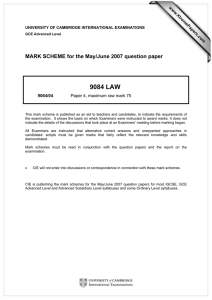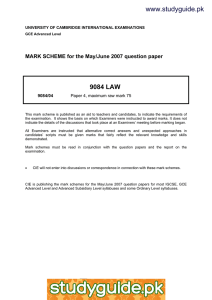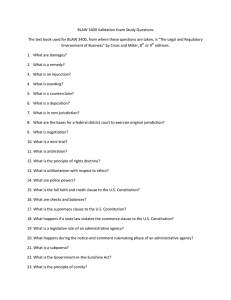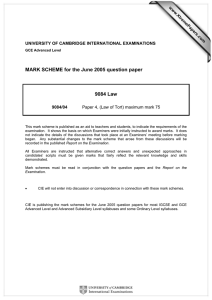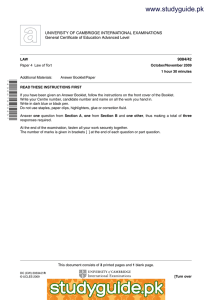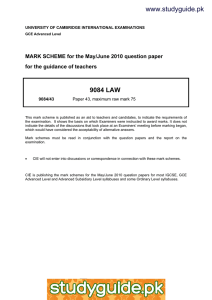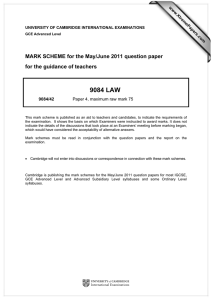9084 LAW MARK SCHEME for the May/June 2009 question paper
advertisement
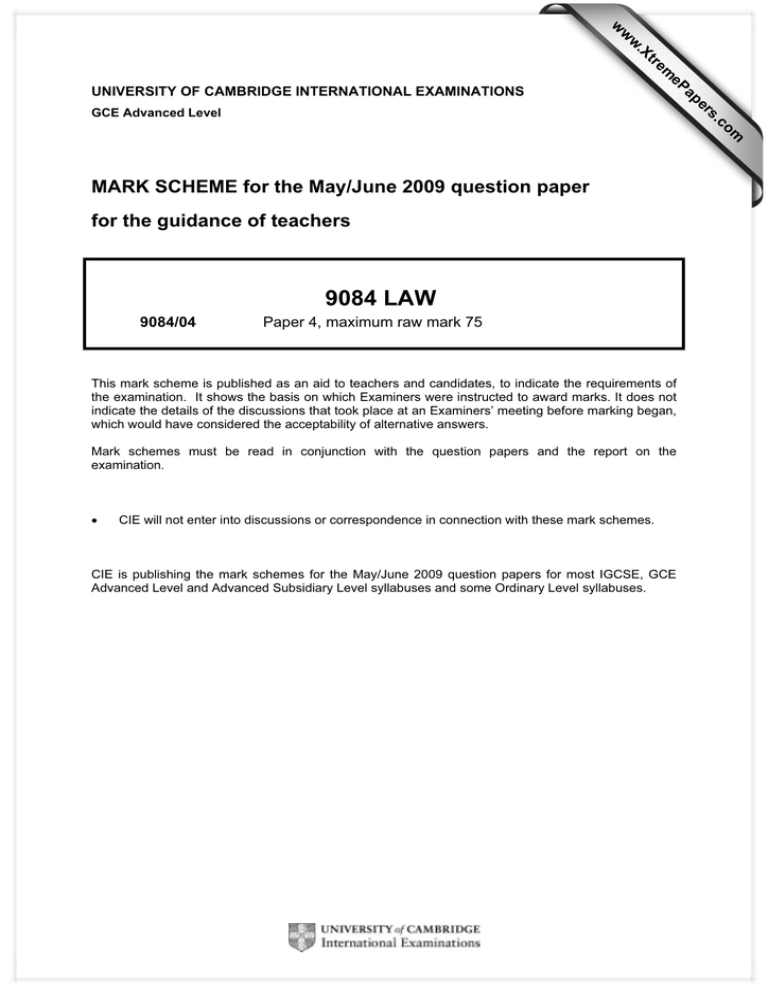
w w ap eP m e tr .X w UNIVERSITY OF CAMBRIDGE INTERNATIONAL EXAMINATIONS s er om .c GCE Advanced Level MARK SCHEME for the May/June 2009 question paper for the guidance of teachers 9084 LAW 9084/04 Paper 4, maximum raw mark 75 This mark scheme is published as an aid to teachers and candidates, to indicate the requirements of the examination. It shows the basis on which Examiners were instructed to award marks. It does not indicate the details of the discussions that took place at an Examiners’ meeting before marking began, which would have considered the acceptability of alternative answers. Mark schemes must be read in conjunction with the question papers and the report on the examination. • CIE will not enter into discussions or correspondence in connection with these mark schemes. CIE is publishing the mark schemes for the May/June 2009 question papers for most IGCSE, GCE Advanced Level and Advanced Subsidiary Level syllabuses and some Ordinary Level syllabuses. Page 2 Mark Scheme: Teachers’ version GCE A LEVEL – May/June 2009 Syllabus 9084 Paper 04 Assessment Objectives Candidates are expected to demonstrate: Knowledge and Understanding – recall, select, use and develop knowledge and understanding of legal principles and rules by means of example and citation Analysis, Evaluation and Application – analyse and evaluate legal materials, situations and issues and accurately apply appropriate principles and rules Communication and Presentation – use appropriate legal terminology to present logical and coherent argument and to communicate relevant material in a clear and concise manner Specification Grid The relationship between the Assessment Objectives and this individual component is detailed below. The objectives are weighted to give an indication of their relative importance, rather than to provide a precise statement of the percentage mark allocation to particular assessment objectives. Assessment Objective Knowledge/ Understanding Analysis/ Evaluation/ Application Communication/ Presentation Paper 1 Paper 2 Paper 3 Paper 4 Advanced Level 50 50 50 50 50 40 40 40 40 40 10 10 10 10 10 © UCLES 2009 Page 3 Mark Scheme: Teachers’ version GCE A LEVEL – May/June 2009 Syllabus 9084 Paper 04 Mark Bands The mark bands and descriptors applicable to all questions on the paper are as follows. Maximum mark allocations are indicated in the table at the foot of the page. Indicative content for each of the questions follows overleaf. Band 1 The answer contains no relevant material. Band 2 The candidate introduces fragments of information or unexplained examples from which no coherent explanation or analysis can emerge. OR The candidate attempts to introduce an explanation and/or analysis but it is so fundamentally undermined by error and confusion that it remains substantially incoherent. Band 3 The candidate begins to indicate some capacity for explanation and analysis by introducing some of the issues, but explanations are limited and superficial. OR The candidate adopts an approach in which there is concentration on explanation in terms of facts presented rather than through the development and explanation of legal principles and rules. OR The candidate attempts to introduce material across the range of potential content, but it is weak or confused so that no real explanation or conclusion emerges. Band 4 Where there is more than one issue, the candidate demonstrates a clear understanding of one of the main issues of the question, giving explanations and using illustrations so that a full and detailed picture is presented of this issue. OR The candidate presents a more limited explanation of all parts of the answer, but there is some lack of detail or superficiality in respect of either or both so that the answer is not fully rounded. Band 5 The candidate presents a detailed explanation and discussion of all areas of relevant law and, while there may be some minor inaccuracies and/or imbalance, a coherent explanation emerges. Maximum Mark Allocations: Question Band 1 Band 2 Band 3 Band 4 Band 5 1 0 6 12 19 25 2 0 6 12 19 25 3 0 6 12 19 25 4 0 6 12 19 25 5 0 6 12 19 25 6 0 6 12 19 25 © UCLES 2009 Page 4 Mark Scheme: Teachers’ version GCE A LEVEL – May/June 2009 Syllabus 9084 Paper 04 Section A 1 With reference to case law, critically assess the extent to which negligence can be considered to be a fault-based tort. Responses to this question should be introduced by an explanation of the meaning of fault in the context of tort law: the relevant act or omission, resulting loss or damage (as necessary) and intention, malice or negligence as required. A brief consideration of why fault is deemed necessary would add value to the response at this juncture. Material should then be contextualised to address the tort of negligence in particular. The question requires candidates to evaluate the extent to which fault is required in the tort of negligence. Consequently candidates must evaluate the basic elements of the tort: duty of care, breach of duty and resultant loss and draw conclusions in the light of the question set. Whilst credit should be given for the factual recall of principles and their development, the main thrust of the question requires a critical assessment of the value of the developments and whether they have contributed to a dilution or concentration of the fault requirement. Candidate responses that are limited to factual recall, however detailed, will be restricted to band 3 marks; critical assessment of the law is essential. 2 Some lawyers would argue that the Rule in Rylands v Fletcher is unnecessary because other torts are sufficient to address the relevant issues. Critically evaluate this view. Candidates are expected to outline the elements of the tort and explain the circumstances in which it is used. The question set requires candidate to comment on whether the tort fills a necessary gap in existing tort law. What limitations were there to the existing fault-based tort of negligence that meant that it could not cover the same purpose? Strict liability. What about the tort of nuisance; wasn’t its scope sufficiently wide? Ref. accumulation & likeliness to cause injury. Could the tort of trespass have helped out? Direct v non-direct interference. Candidate responses that are limited to factual recall, however detailed, will be restricted to band 3 marks; critical assessment of the law is essential. © UCLES 2009 Page 5 3 Mark Scheme: Teachers’ version GCE A LEVEL – May/June 2009 Syllabus 9084 Paper 04 The usual reason for awards of damages in tort is to compensate victims. Using case law to support your answer, analyse the circumstances in which noncompensatory awards might be made instead. Damages in tort are intended to put the claimant in the position they would have enjoyed if the tort had never been committed; the aim of damages in tort is to compensate claimants rather than to punish defendants. However, in some cases, damages may be awarded for different reasons and this may result in the award being more than or less than required to directly compensate for the loss suffered. Candidates should identify, explain and evaluate the purpose of the four types of non-compensatory award: contemptuous, nominal, aggravated and exemplary damages. Case law examples should be used wherever possible to illustrate the purpose of the award and to evaluate the extent the purpose was achieved. Examples (non-exhaustive) might include Constantine v Imperial London Hotels, Khodaparast v Shad, Rookes v Barnard etc. Limitations on the use of exemplary awards should also be addressed. Candidates must attempt to evaluate the statement. Responses limited to factual recall of principle will be restricted to maximum marks within band 3. Section B 4 Advise Jenny and Philip whether they have grounds for any claim in tort against Joseph and assess the likelihood of the success of their claims. The scenario points to an act of negligence by the coach driver concerned. Negligence should be defined and the three elements of the tort, namely duty of care, breach of duty and resultant damage, ought to be reviewed at least in outline. Candidates should also be credited for exploring the possibility that the maxim res iopsa loquitur might apply in this case. Why would a coach end up on its roof but for the driver’s carlessness? If introduced, candidates must also explore the implication for the burden of proof. Assuming that negligence is established, what of the liability for the rescuers’ injuries? Could they be described as having acted voluntarily and therefore consented to the risk of injury? Would the driver not be liable therefore? Was the risk taken a necessary one? Was the risk undertaken instinctively or was the doctor simply carrying out her duty to intervene? Case law such as Haynes v Harwood, Cutler v United Dairies and Chadwick v British Railways Board must be explored. Whatever conclusions are reached they should be clear, compelling and fully supported by references to case law. © UCLES 2009 Page 6 5 Mark Scheme: Teachers’ version GCE A LEVEL – May/June 2009 Syllabus 9084 Paper 04 Consider the theme-park’s potential liability in tort for the loss sustained by Pierre and Luc in the situation above. How successful might any defences be? This scenario points to the issue of the liability of occupiers for injuries to those who enter their premises, whether as visitors or as trespassers. In addition, the facts presented also raise the issue of whether or not such liability can be legitimately excluded. When the family enters the park they clearly enter as paying visitors and thus the Occupiers Liability Act 1957 will apply. Candidates should outline the main provisions and discuss whether or not the theme-park owners have discharged their liability towards the family, given the injury sustained by Pierre. Would the notice displayed at the entrance discharge the owners from liability for these injuries, given the provisions of the Unfair Contract Terms Act? What of the injuries to Luc? He clearly entered part of the premises which was not open to the public and therefore became a trespasser. But he is only a child, so what impact does that have, if any? What does the Occupiers Liability Act 1984 have to say about liability towards trespassers? Can notices absolve occupiers from liability? Candidates must also address possible defences such as consent and contributory negligence. Whatever conclusions are reached they should be clear, compelling and fully supported by references to case law. 6 Discuss the potential liability in tort of both parties involved and consider what defences might be successfully raised by either party. The principal thrust of this scenario concerns the torts of private nuisance, of trespass to land and remedies thereto. The two torts need to be defined and the principal requirements of an actionable state of affairs should be outlined in each case. Do the overhanging branches constitute a private nuisance? What indirect interference with Nasir’s use or enjoyment of property is caused? Is it an unreasonable interference or are the falling leaves simply a product of nature which everyone has to put up with? What of trespass to land – does this amount to trespass to air space? sufficiently direct to be actionable? Is the interference In either event, is self-help an appropriate remedy to abate either an act of nuisance or trespass? Does the throwing of the branches back into Mahmoud’s garden create any liability on Nazir’s part? And what about the additional garden refuse? The prospect of continuing trespass ought to be explored in this case. Whatever conclusions are reached they should be clear, compelling and fully supported by references to case law. . © UCLES 2009


